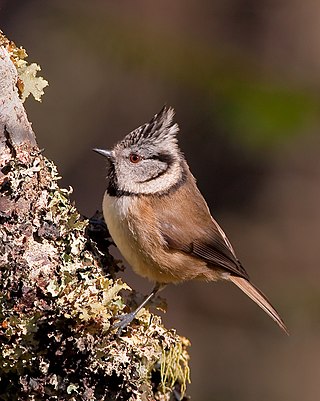
The tits, chickadees, and titmice constitute the Paridae, a large family of small passerine birds which occur mainly in the Northern Hemisphere and Africa. Most were formerly classified in the genus Parus.

The ground tit, Tibetan ground-tit or Hume's ground-tit is a bird of the Tibetan plateau north of the Himalayas. The peculiar appearance confused ornithologists in the past who called it as Hume's groundpecker and still later as Hume's ground jay or Tibetan ground jay assuming that it belonged to the family Corvidae that includes the crows and jays. Although morphologically confusing, the species has since been identified using molecular sequence comparisons as being a member of the tit family (Paridae) and is the only species in the genus Pseudopodoces. It is found in the Tibetan Plateau of China, India, Nepal & Bhutan.
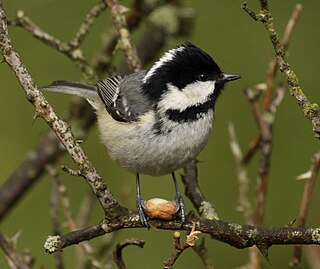
The coal tit or cole tit,, is a small passerine bird in the tit family, Paridae. It is a widespread and common resident breeder in forests throughout the temperate to subtropical Palearctic, including North Africa. The black-crested tit is now usually included in this species.
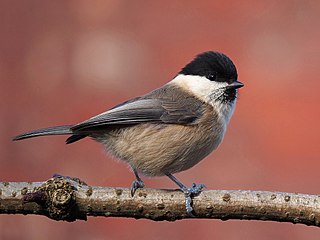
The willow tit is a passerine bird in the tit family, Paridae. It is a widespread and common resident breeder throughout temperate and subarctic Europe and across the Palearctic. The plumage is grey-brown and off-white with a black cap and bib. It is more of a conifer specialist than the closely related marsh tit, which explains it breeding much further north. It is resident, and most birds do not migrate.
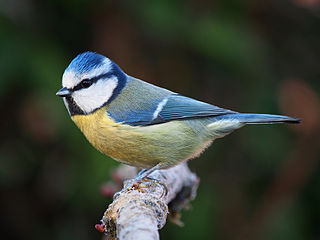
The Eurasian blue tit is a small passerine bird in the tit family, Paridae. It is easily recognisable by its blue and yellow plumage and small size.

The parrotbills are a family, Paradoxornithidae, of passerine birds that are primarily native to East and Southeast Asia, though feral populations exist elsewhere. They are generally small, long-tailed birds that inhabit reedbeds and similar habitats. They feed mainly on seeds, e.g. of grasses, to which their bill, as the name implies, is well-adapted. Living in tropical to southern temperate climates, they are usually non-migratory.
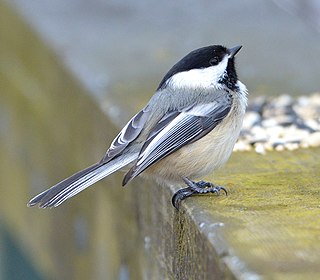
The black-capped chickadee is a small, nonmigratory, North American songbird that lives in deciduous and mixed forests. It is a passerine bird in the tit family, the Paridae. It is the state bird of Massachusetts and Maine in the United States, and the provincial bird of New Brunswick in Canada. It is well known for its ability to lower its body temperature during cold winter nights, its good spatial memory to relocate the caches where it stores food, and its boldness near humans.

The Carolina chickadee is a small passerine bird in the tit family Paridae.
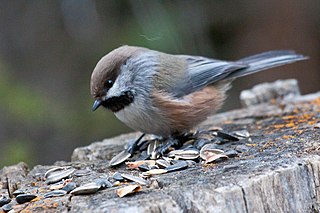
The boreal chickadee is a small passerine songbird in the tit family Paridae. It is found in the boreal forests of Canada and the northern United States and remains within this range all year. This bird is known for its high pitched trill patterns used in communication with other birds and food storage habits in preparation for winter months.

The Himalayan black-lored tit, also known as simply black-lored tit, is a passerine bird in the tit family Paridae. The yellow-cheeked tit is probably its closest relative, and it may also be related to the yellow tit. These three tits almost certainly form a distinct lineage, as indicated by morphology, and mtDNA cytochrome b sequence analysis.
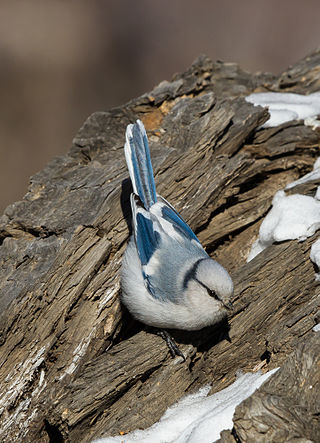
The azure tit is a passerine bird in the tit family Paridae. It is a widespread and common resident breeder throughout Russia, Central Asia, northwest China, Manchuria, and Pakistan.

The mountain chickadee is a small songbird, a passerine bird in the tit family Paridae.

The Mexican chickadee is a small songbird, a passerine bird in the tit family Paridae. It is still often placed in the genus Parus with most other tits, but mtDNA cytochrome b sequence data and morphology suggest that separating Poecile more adequately expresses these birds' relationships. The American Ornithologists' Union had been treating Poecile as distinct genus for some time already.

The chestnut-backed chickadee, formerly Parus rufescens, is a small passerine bird in the tit family, Paridae.

The sultan tit is an Asian forest bird with a yellow crest, dark bill, black upperparts plumage and yellow underparts. The sexes are similar. The female has greenish-black upperparts and a yellowish throat. The young bird is duller than the adult and has a shorter crest. It is the only member of the monotypic genus Melanochlora, which is fairly distinct from the Parus tits with the nearest relative being the monotypic Sylviparus.

Poecile is a genus of birds in the tit family Paridae. It contains 15 species, which are scattered across North America, Europe and Asia; the North American species are the chickadees. In the past, most authorities retained Poecile as a subgenus within the genus Parus, but treatment as a distinct genus, initiated by the American Ornithologists Union, is now widely accepted. This is supported by mtDNA cytochrome b sequence analysis.
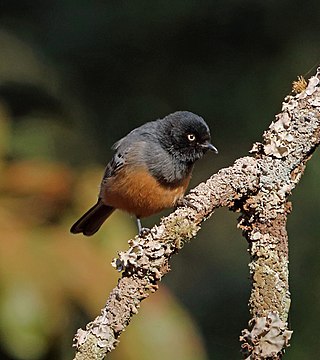
Melaniparus is a genus of birds in the tit family. The species were formerly placed in the speciose genus Parus but were moved to Melaniparus based on a molecular phylogenetic analysis published in 2013 that showed that the members formed a distinct clade. The genus Melaniparus had originally been introduced by the French naturalist Charles Lucien Bonaparte in 1850. The type species was subsequently designated as the southern black tit. The name of the genus combines the Ancient Greek melas, melanos "black" and the genus Parus introduced by Carl Linnaeus in 1758.

The white-shouldered black tit, also known as the pale-eyed black tit, is a passerine bird in the tit family. It breeds in a belt across Africa from Senegal in the west to Kenya and Ethiopia in the east. It is sometimes considered conspecific with the more southerly white-winged black tit Melaniparus leucomelas and, like that species, it is mainly black with a white wing patch, but differs in that it has a pale eye.

The Caspian tit is a passerine bird in the tit family. It breeds in the deciduous mountain forests of northern Iran, just extending into Azerbaijan.

The Indian black-lored tit, Indian tit, or Indian yellow tit is a passerine bird in the tit family Paridae. The yellow-cheeked tit is probably its closest relative, and both may be related to the yellow tit. These three tits almost certainly form a distinct lineage as evidenced by morphology, and mtDNA cytochrome b sequence analysis. The subgenus name Macholophus may apply for them.



















